Brian Van der Horst
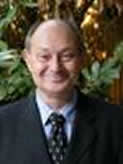
Brian van der Horst
Modes of Explanation, “A Discussion Conference” was held here in Paris—the perfect venue for a post, postmodern gathering of cognitive scientists– on May 21-25.
Some 50 participants from around the world included experts in neuroscience and complex adaptive systems theory, theoretical computer science, anthropology, cybernetics, sustainability, complexity, philosophy of science, creativity, art and managing, polyphony (organization studies) and performance studies (culture & organization), perceptual psychology, cognitive psychology, environmental psychology, industrial design, human–computer interaction (HCI), interaction design, instructional design, science, technology and society (STS), and artificial intelligence. Fundamentally, this was a meeting about how we make sense and create results in the world, featuring experts that shared real-world applications of a little-known field which might soon comprise a new discipline directly applicable to leadership.
In his book, “Sync: How Order Emerges From Chaos In the Universe, Nature, and Daily Life,” Steven Stogatz said that “every decade or so, a grandiose theory comes along, bearing similar aspirations and often brandishing an ominous-sounding C-name. In the 1960s, it was cybernetics. In the ‘70s it was catastrophe theory. Then came Chaos Theory in the ‘80s and Complexity Theory in the ‘90s.” Stogatz stated that complexity theory largely failed to explain where the unexpected emerging order comes from in a mathematical sense. Also that it failed in tying the theory to real phenomena in a convincing way. And some believe that uncovering the universe’s last secrets, possibly that it might just be one giant computer, might lead to the end of science, or if human beings are uploaded in singularity of machine/man fusion, it would be the end of life as we know it.
Some would say that cybernetics, chaos, catastrophe, complexity theory have each come and gone, but this conference was a demonstration that in academia and the real world, they are very much alive. “They” have become “Us.” Or, if like your author you’ve been teaching and doing this stuff for 30 years, “we” have become “them.” Maybe in the ‘00s, the big idea was Cognitive-Integral?
Organized by Michael Lissack and his Institute for the Study of Coherence and Emergence, this event reminded me of the Macy Conferences held in New York from 1946 to 1953. In those landmark meetings organized by neurophysiologist and cybernetician Warren McCulloch and the Josiah Macy, Jr. Foundation from 1946 to 1953, they were perhaps the first truly interdisciplinary meetings of modern times. Featuring such pioneering “hard” scientists as William Ross Ashby, Heinz von Foerster, Julian Bigelow, John von Neumann, Walter Pitts, Norbert Wiener, Karl Pribram, Claude Shannon, with such eminent social scientists as Gregory Bateson, Eric Erikson, Margaret Mead, Noam Chomsky, George Miller, and Talcott Parsons. At the Macy Conferences, discussions actually generated seminal fields such as neural networks, feedback and cybernetics, psychological models from memory, gestalt and developmental approaches, information, complexity and decision theory and virtually launched the foundations for the invention of modern computing, management theory, and the web-based fabric of our current lives.
In terms of pointing to new horizons of cognitive theory, including applications in computing and programming languages, the Modes of Expression Paris conference offered a similar meeting of minds, where not only were notables from disparate disciplines actually communicated, but also offered concrete examples of what most of us would take as high-altitude abstractions.
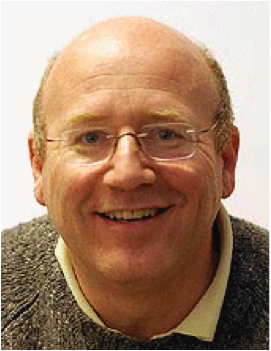
Michael Lissack

Conference in the Midst of Complexity
Besides founding the conference sponsor, ISCE, a non-profit research institute on complexity, coherence, and various cognitive approaches,( http://isce.edu/ ) conference organizer Michael Lissack, is quite a complex character in himself. He launched an international PhD program in corporate anthropology, has written a half dozen books – many about organizational management and complexity (http://goo.gl/4TVuD)” – and started a successful academic journal, Emergence: A Journal of Complexity Issues in Organizations and Management now known as E:CO.
“Modes of Explanation” is one of nine international conferences on the topics of complexity, management, health care, entanglement and ethics that Michael has produced in the past few years. During the ISCE he was inspired to hold this conference so as to better understand how our mode of explanation affects our affordances (contexts of possibilities) for action. For instance, putting a couple of cups on the table with handles affords the possibilities of picking them up with a pistol grip of your fingers. A few tumblers suggest a full-palm grasp.
The conference was structured around plenary presentations alternating with open-ended discussions between three groups assembled by Lissack. “My game plan is to produce two books from this conference as a function of what speakers say and what emerges from the discussions.”
“The challenge to prospective attendees,” wrote Michael, “is to prepare a presentation which can evoke meaningful discussion amongst the attendees… for example, focus on:
1) How we go about explaining and the limitations/strengths of our approach,
2) What kinds of explanations ‘work’ and which kinds ‘fail,’
3) The context dependency of explanatory form
4) The differences in use between “good enough explanation” and “truth claims”
5) The need for/use of mechanisms and “narratives” as a meaning of “explaining” (making understandable in a coherent way) some aspect of complexity or of a real in life complex system
6) How a reliance on sameness or of category as a simplifying reduction was inadequate to the situation being examined or
7) How modes of explanation vary by discipline.”
Michael is an accomplished academic who also knows business better than most. He’s been a successful Wall Street banker, a candidate for public office, and currently owns a realty business and management consultancy in Florida. Worth Magazine recognized Dr. Lissack as one of “Wall Street’s 25 Smartest Players” in 1999 and as one of the 100 Americans who have most influenced “how we think about money” in 2001.
During the 1990s he was famous as a whistle blower who exposed a yield burning scandal where financial firms made illegal profits from the structuring of U.S. Government investment portfolios associated with municipal bonds. Since he discovered these illegalities while serving as a managing director in the municipal bond department at Smith Barney, he paid a $30,000 fine and was banned from Wall Street for five years.
This was balanced by the bounty he received from the government. A number of firms settled $200 million with the justice department; Lissack was entitled to at least 15% under federal whistle blower laws. Lissack spent some of his share endowing a professorship in Social Responsibility and Personal Ethics at his alma mater, Williams College. As late as 2010, he was still whistle blowing, but this time in the housing development industry.
In his opening presentation, Dr. Lissack outlined some of the background approaches, sciences and philosophical orientations of the conference. 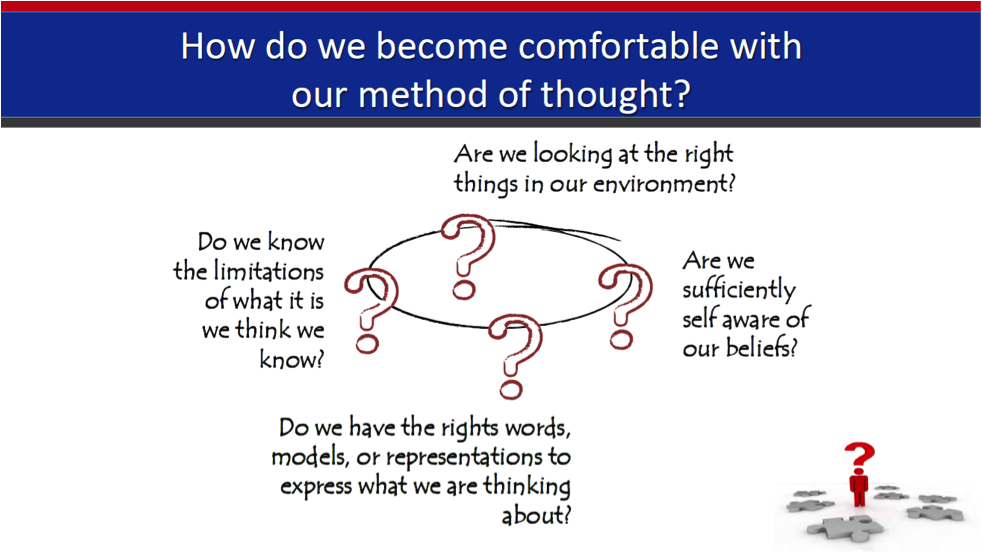
His presentation, featured overviews of how ontology (how things come into being) and epistemology (how we know what we know) form structures for all our communications and actions. A major distinction used during the meeting was the difference between traditional, representational science and post-modern intuitive science, which he and the veteran participants referred to as Science I and Science II.

For a fascinating series of presentations, including the slides Michael used to kick off the conference, see: http://www.modesofexplanation.org/#!concept|c1q5e
If you want to start a new discipline, you can find most of the tools presented at this conference at this address: http://epi-thinking.org/index.html#%21/page_Home

Zachary Kopplin
Nineteen year-old Zachary Sawyer “Zack” Kopplin, the next presenter in the conference offered an astonishing application of these academic methods. As a senior at Baton Rouge Magnet High School, in Louisiana, Kopplin enlisted the help of Nobel laureate chemist, Harry Kroto, and the support of 78 Nobel laureate scientists, to repeal the Louisiana Science Education Act, which has been described by the international science community as a creationism law. Politically, Kopplin enlisted Louisiana State Senator Karen Carter Peterson, a Democrat from New Orleans and Chair of the Louisiana Democratic Party. As a result of his efforts with evolution expert Judy Scotchmoor in schools and on public media platforms, both won the National Center for Science Education’s 2012 Friend of Darwin Award Winner and also the2012 Hugh M. Hefner First Amendment Award in Education.

Nancy Nersessian
Next on the conference podium was Nancy Nersessian , Professor of Cognitive Science at the Georgia Institute of Technology. She is appointed jointly in the School of Public Policy and the College of Computing, and holds an adjunct appointment in the School of Architecture. Her research focuses on human creativity in science, conceptual innovation and change in science, and engineering research and learning, specifically the role of analogical and visual modeling and thought experimenting (simulative modeling). Her current research includes investigating reasoning and representational procedures in interdisciplinary research laboratories.
Dr. Neressian shared her work with creating scientific and computing models from nature, or bio-simulation to produce “understanding to reveal, show, provide insight, get a grip, a gut feeling and to predict.” Indeed her neuro-engineering research has created computational simulations of understanding, explanation, and various mechanisms of learning including neural networks and a living robotic artist that “learned to draw within the lines.”
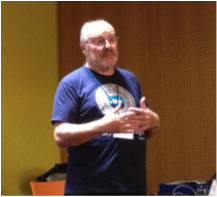
David Snowden
David Snowdon, a sometime co-author with Lissack, has one of the most renowned business reputations among the speakers. He was the lead author of a November 2007 cover story in the Harvard Business Review: “A Leader’s Framework for Decision Making,” in which his team reported on the complexity management tool Snowden developed when he was a director in the IBM Institute for Knowledge Management, called Cynefin (a Welsh word that signifies “habitat,” and the “multiple factors in our environment and our experience that influence us in ways we can never understand”. 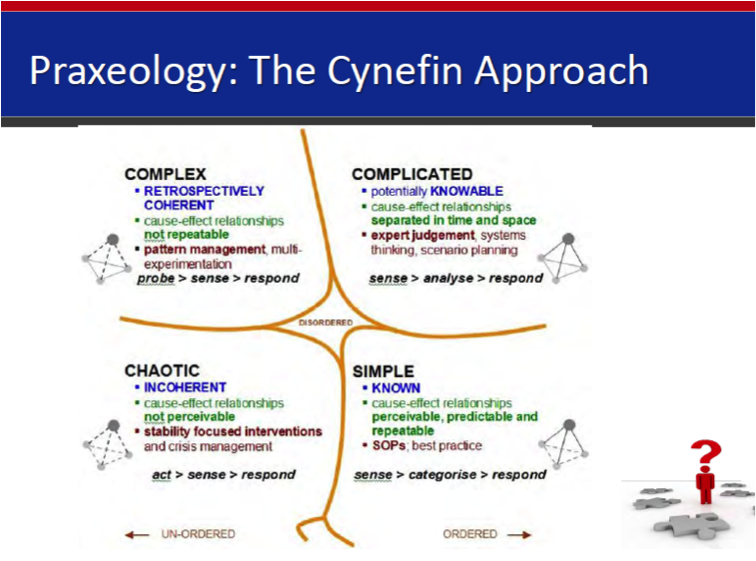
Snowden is a great raconteur, and led off talking about his development of narrative as a research method, citing how interviewing the stories of 5000 Columbian school children proved more useful for designing educational programs than any government research. In one of the later discussion sessions, David also described how his Cognitive Edge consulting firm( http://cognitive-edge.com/ ) reduced accidents at a liquid oxygen company by creating what Milton Erickson used to call an “isomorphic tasking metaphor.” He arranged awkward trays for carrying hot coffee in the worker’s lunchroom, creating personal narrative experiences of how to be careful around dangerous liquids. Accidents were subsequently halved. Snowden also revealed that at IBM, the company’s research team “proved that astrology was better in predicting behavior than the Myers-Briggs inventory… myths are strange attractors” (for resolving chaos and complexity).
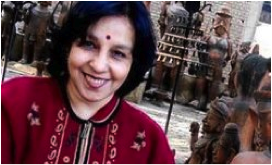
Rukmini Bhaya Nair
Rukmini Bhaya Nair is an acclaimed Indian poet as well as the author of many academic volumes including Technobrat: Culture in a Cybernetic Classroom (Harper Collins, 1997); Narrative Gravity: Conversation, Cognition, Culture (Oxford University Press and Routledge, London and New York, 2003); Lying on the Postcolonial Couch: the Idea of Indifference (Minnesota University Press and Oxford University Press, India, 2002); an edited volume, Translation, Text and Theory: the Paradigm of India (Sage, 2002). Her latest major grant is from the Indian Ministry of Science and Technology to conduct basic research in cognitive science on the theme of “Language, Emotion and Culture” (2009-2012). http://web.iitd.ac.in/~rbnair/
In a dazzling presentation filled with art, science and whimsy, Dr. Nair fulfilled her conference description, and “asked why human beings across the world are such compulsive and inventive storytellers. Extending current research in cognitive science and narratology, she argued that we seem to have a genetic drive to fabricate stories as a way of gaining the competitive advantages such fictions give us. She suggests that stories are a means of fusing causal and logical explanations of ‘real’ events with emotional recognition, so that the lessons taught to us as children, and then throughout our lives via stories, lay the cornerstones of our most crucial beliefs. Nair’s conclusion is that our stories really do make us up, just as much as we make up our stories.”
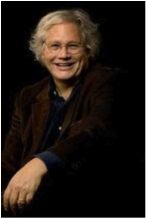
Hugo Letiche
Hugo Letiche, Professor at the University of Leicester’s School of Management, is the author of books on organizations and belief, complexity and coherence is another Lissack co-conspirator. His recent writings have been on sustainability, examined from a complexity perspective (E:CO); creativity, art and managing (Society Business Review); polyphony (Organization Studies) and performance studies (Culture & Organization).
Dr. Letiche presented a lecture on “Zombie Complexity,” remarking that “Zombies” are a concept popular in South Africa in which rich women are said to be making their money by employing the disinterred dead at night. Is social complexity theory a politically and philosophically mindless (Zombie) or a mindful theory?
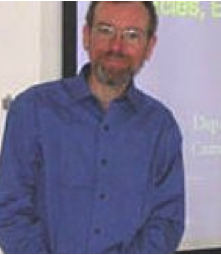
Kevin Kelly
Kevin T. Kelly, a professor of the philosophy of science at Carnegie Mellon, started out clarifying that he wasn’t the “0ther” namesake that worked at Wired Magazine. He presented a simplified discussion of Okham’s Razor and Realism, http://www.andrew.cmu.edu/user/kk3n/ockham/Ockham.htm “I am mainly interested in how scientific method could possibly lead us to true generalizations about Nature, generalizations that extend infinitely beyond our current, finite perspective. Standard philosophy of science sidesteps this question by asking, instead, about the meanings of justification’ and ‘rationality’ a different matter entirely.”
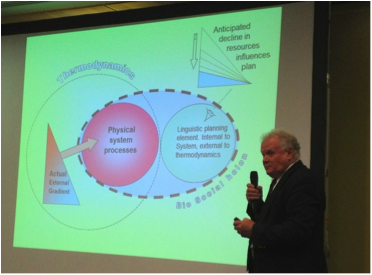
Timothy Allen
Timothy Allen started out as a plant community ecologist studying algae. “My research liaisons provide a scale-based theoretical framework for groups at the Northern Lakes Long Term Ecological Research site and Oak Ridge National Laboratory. The U. S. Forest Service in Fort Collins, Colorado, and the Science Advisory Board for the US/ Canadian International Joint Commission provide an outlet for me to practical problems. Allen uses the concept of “Holons” familiar to integral theorists in his work, and spoke on behalf of using narratives and ecological hierarcies in his work.
“My sentiments with regard to an appropriate balance between theory and experimentation were stated in my Hutchins’ 1933 Commencement Address in Chicago: ‘The gadgeteers and data collectors, masquerading as scientists, have threatened to become the supreme chieftains of the scholarly world…. As the Renaissance could accuse the Middle Ages of being rich in principles and poor in facts, we are now entitled to inquire whether we are not rich in facts and poor in principles.’ We are tyrannized by our technology telling us how things work, because that blunts our curiosity and confidence as to how things might otherwise work.
“There are theorists and gurus who claim pieces of complexity, but their analyses are often incomplete or naive. With emergence, contexts change, and so observers must change their decisions as to the structures they assert. Models are not the point of it all, but narratives improved by challenges from models are. I take a post-modern view, where it is the intrinsic process of science that lends quality. Truth is beside the point, in a complex world perceived in infinity of ways.”
For a example of Allen’s great wisdom coupled with a wicked sense of humor, see https://www.youtube.com/watch?feature=player_embedded&v=rdrGxTfnpsw#!

Paul Thagard
Paul Thagard concluded the speaker’s program. Specializing in the philosophy of science, psychology, and computer science, Paul is director of the cognitive science program at the University of Waterloo in Ontario, and a prolific author on hard science computing – and a series of delightfully popular introductions to the sciences of the mind. http://www.amazon.com/Paul-Thagard/e/B001IOF9MQ
Thagard developed cognitive perspectives on the nature of explanation, mental models, theory choice, and resistance to scientific change and showed how discoveries of new theories and explanations lead to conceptual change and can integrate descriptive and normative concerns. For samples of his wide range of accessible expertise, try browsing through the blog he writes for “Psychology Today,” at http://www.psychologytoday.com/blog/hot-thought .
Each of the above plenary sessions was separated by discussions in breakout groups of from 12 to 15 people. In my group, long discussions on narrative approaches to solving world and organizations problems were coupled with brainstorming on how to reverse trends in creationism, and resolving complexity in the post-postmodern world. Our group slanted toward these topics, of course, since Thagard, Snowden, Kopplin and Allen were among our members. In other groups, metaphorical, narrative, cybernetic and third world development showed up as topics often in relationship to the speakers present in respective rooms.
In my opinion, most registered participants from this conference probably went home with a dazzling array of new explanatory and leadership tools. For many of us, the writings and teachings of this field have been relegated to academia. But the business and consulting examples presented here definitely made the case that the modalities of explanation discussed this week here in Paris are generating much good work in the world, and sizable profits in consulting. If you are working in promoting leadership, I recommend checking out the various resources and URLs detailed in the above report.
About the Author
Brian Van der Horst has been a management trainer, consultant and executive coach since 1977. IN 1984, he began to live and work in Europe, based in Paris where he founded Repère, an international training institute, with two French consultants, designing and teaching certification programs to more than 10,000 people world-wide. In 1994, he founded a coaching school, and has certified around 300 coaches. For the past few years, he has been an Program Development Director for Renaissance 2; and a founding member and Chief Facilitator, Europe, for Ken Wilber’s Integral Institute. Previously he was director of the Neuro-Linguistic Programming Center for Advanced Studies in San Francisco, and a consultant with Stanford Research Institute in the Values and Lifestyles Program of the Strategic Environments Group.
Van der Horst has taught at John F. Kennedy University in Orinda, California; The California State University, Sonoma; the University of Paris XIV, and XIII; and Apple University, France; and has given seminars on intercultural management, negotiation and communication for MBA students at the Sorbonne, the International Management Institute in Paris, and at the Institut d’Administration des Enterprises in Aix-en-Provence. He has also given leadership, team-building, and long-term management training seminars in Moscow, Sao Paulo, Hong Kong, and Indonesia; along with 10 countries in the European Community.
He has worked in journalism as an editor for New Realities, Practical Psychology, Playboy, and The Village Voice. The author of the books, Folk Music in America, Rock Music, and The Outcome Strategy; and over 1,000 magazine and newspaper articles, he has also been an acquisitions editor for J.P. Tarcher Books, Houghton-Mifflin, and hosted a television program in San Francisco. He currently writes for Intelligence, a newsletter on neuro-computing. Before this time, Van der Horst was originally trained in marine biology, but shortly after attending Duke University, worked in the entertainment industry for 10 years, serving as Vice-President of the Cannon Group, and as Director of Advertising and Publicity for Atlantic Records. Van der Horst has been listed in Who’s Who in the World since 1994, and Who’s Who in America since 2007. E-mail: brianvdh@gmail.com
